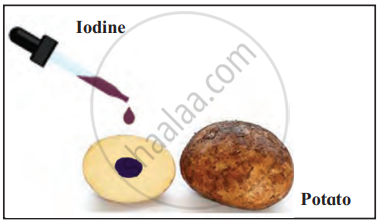1. Aim: To observe the presence of starch in a potato using iodine and understand the role of starchy foods in our diet.
2. Requirements: a piece of potato, a tincture of iodine, water (for dilution), and a dropper.
3. Procedure
- Prepare Iodine Solution: Add a small amount of water to the tincture of iodine to dilute it.
- Apply Iodine: Using a dropper, place a few drops of the iodine solution onto the potato piece.
- Observe: Notice the colour change on the potato piece.
4. Observation: The piece of potato turns blackish blue, indicating the presence of starch.
5. Conclusion: When iodine comes into contact with starch, it turns blackish blue. This shows that the potato contains starch. Other foods like sago, sweet potatoes, and cereals (jowar, bajra, wheat, and rice) also contain starch, which provides energy to our body for various activities and helps maintain body warmth.

